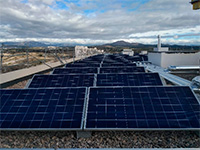In the era of the search for sustainability, architecture and energy must go hand in hand if buildings are to play a key role in the transition towards new city models. Today, the idea that optimizing a building’s energy performance is a constraint on its design is obsolete. As teachers, we therefore have the responsibility to train professionals who understand the need to design efficient buildings that integrate local renewable generation, and who have the necessary skills to find the best way to do so. In this sense, solar photovoltaic energy offers us a great opportunity, due to its growing potential for integration.
In fact, the building integration of solar photovoltaics, known internationally by the acronym BIPV (Building-Integrated Photovoltaics), is one of the key tools for achieving zero-energy or positive-energy buildings 1.
In this type of photovoltaic system, the generating element itself replaces other conventional building components, assuming specific architectural functions such as primary weather impact protection (rain, snow, wind, hail, etc.), shading, daylighting, thermal insulation, structural integrity, fire protection, noise protection, security, etc., in addition to the electricity generation. There are currently photovoltaic building elements on the market designed to be integrated into all parts of the building envelope: in opaque façades, windows, roofs, atriums, skylights, floors, sun shading devices, handrails, etc.

The multifunctionality of BIPV elements (architectural function and electricity generation) provides design possibilities and architectural qualities that are impossible to achieve with photovoltaic systems (the most widespread systems installed in buildings, known internationally as Building-Added Photovoltaics), in which modules designed for the sole purpose of generating energy are added to an envelope that would be perfectly functional without the photovoltaic system.


Although in terms of annual installed capacity the BIPV market still represents less than 1% of the global photovoltaic market 4, there are currently many examples of buildings constructed using solar photovoltaic technology as another building material, which has the peculiarity of requiring for its correct use the interaction and integration of techniques, tools, perspectives and specific skills from different areas of knowledge, such as building physics, bioclimatic architecture, photovoltaic systems engineering, construction, and materials science, just to mention a few 1, 2, 3. These examples of solar architecture demonstrate the new technological possibilities of the building integration of photovoltaics and should be promoted among the sector professionals of tomorrow, to show the architectural quality of BIPV and the enormous potential of a multidisciplinary approach in which engineering, architecture, construction, and sustainability are part of the same design concept.
- N. Martín-Chivelet et al., “Building-Integrated Photovoltaic (BIPV) products and systems: A review of energy-related behavior,” Energy Build., vol. 262, p. 111998, May 2022, doi: 10.1016/j.enbuild.2022.111998.
- SUPSI, Becquerel Institute, Building Integrated Photovoltaics: A practical handbook for solar buildings’ stakeholders, 2020. Available at.: https://repository.supsi.ch/12186/
- IEA PVPS Task 15, Succesful Building Integration of Photovoltaics –A Collection of International Projects, February 2021. Available at.: https://iea-pvps.org/key-topics/succesful-building-integration-of-photovoltaics-a-collection-of-international-projects
- IEA PVPS Trends in Photovoltaic Applications 2021. Available at.: https://iea-pvps.org/trends_reports/trends-in-pv-applications-2021/



